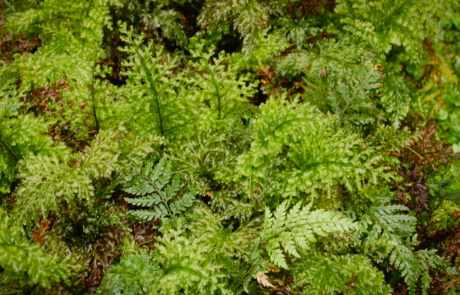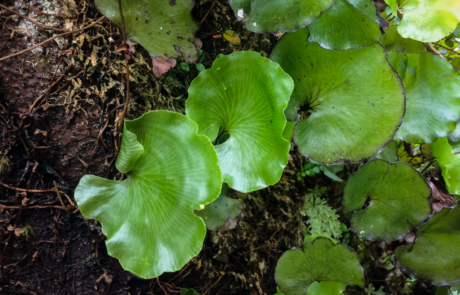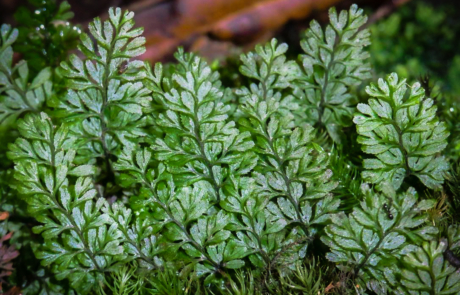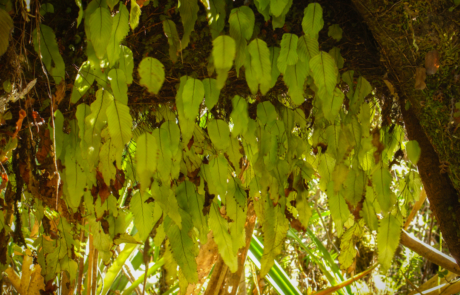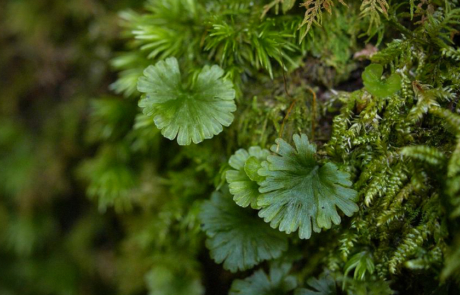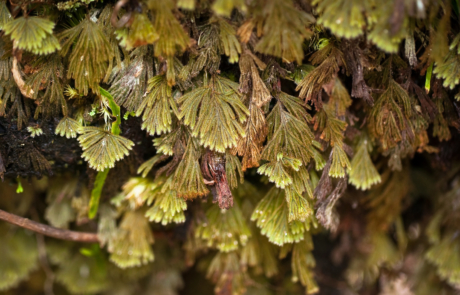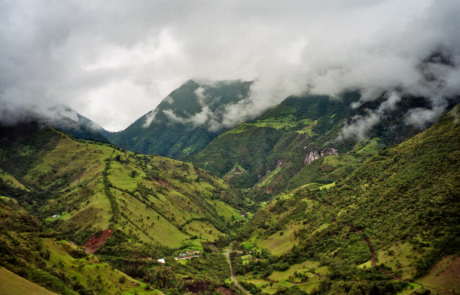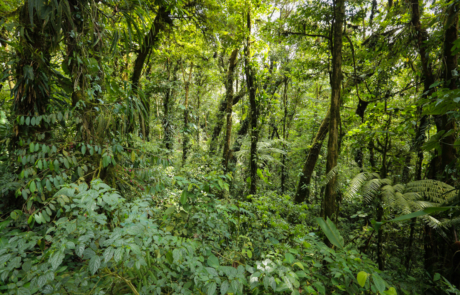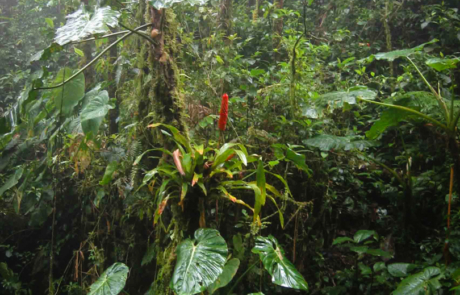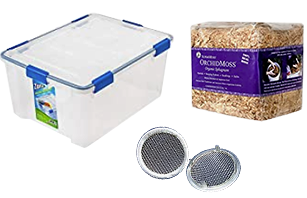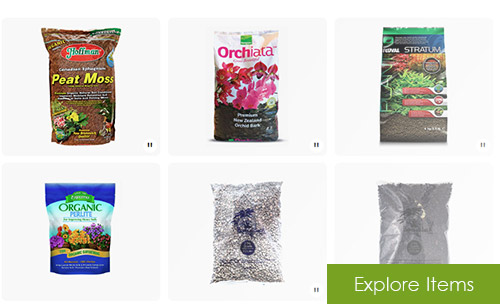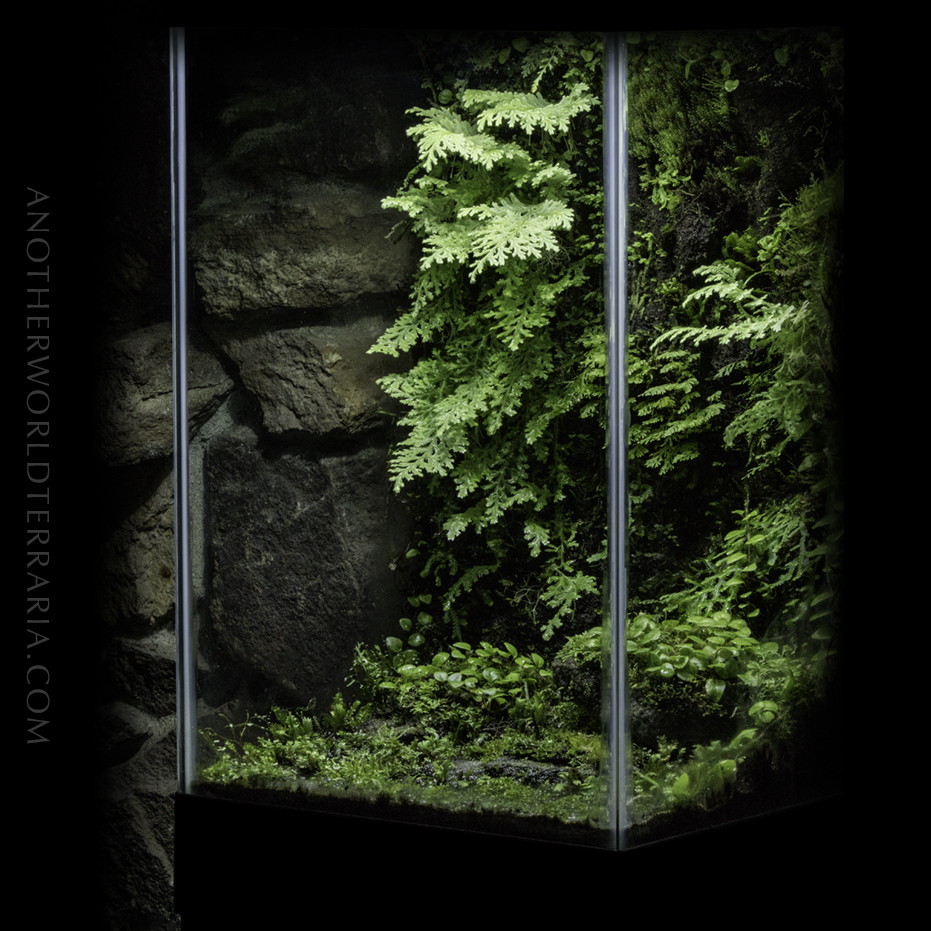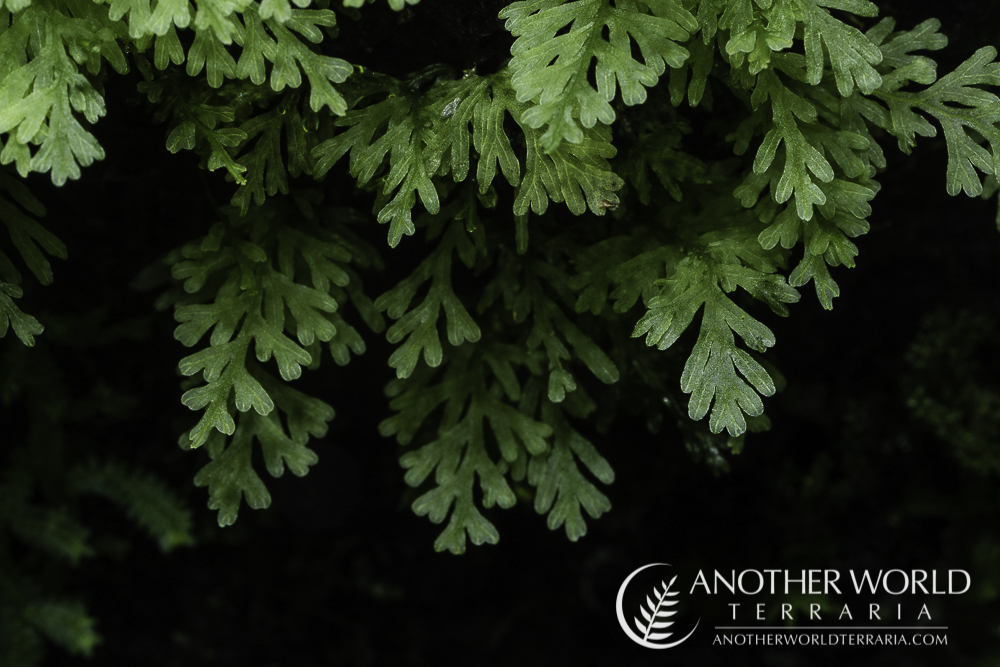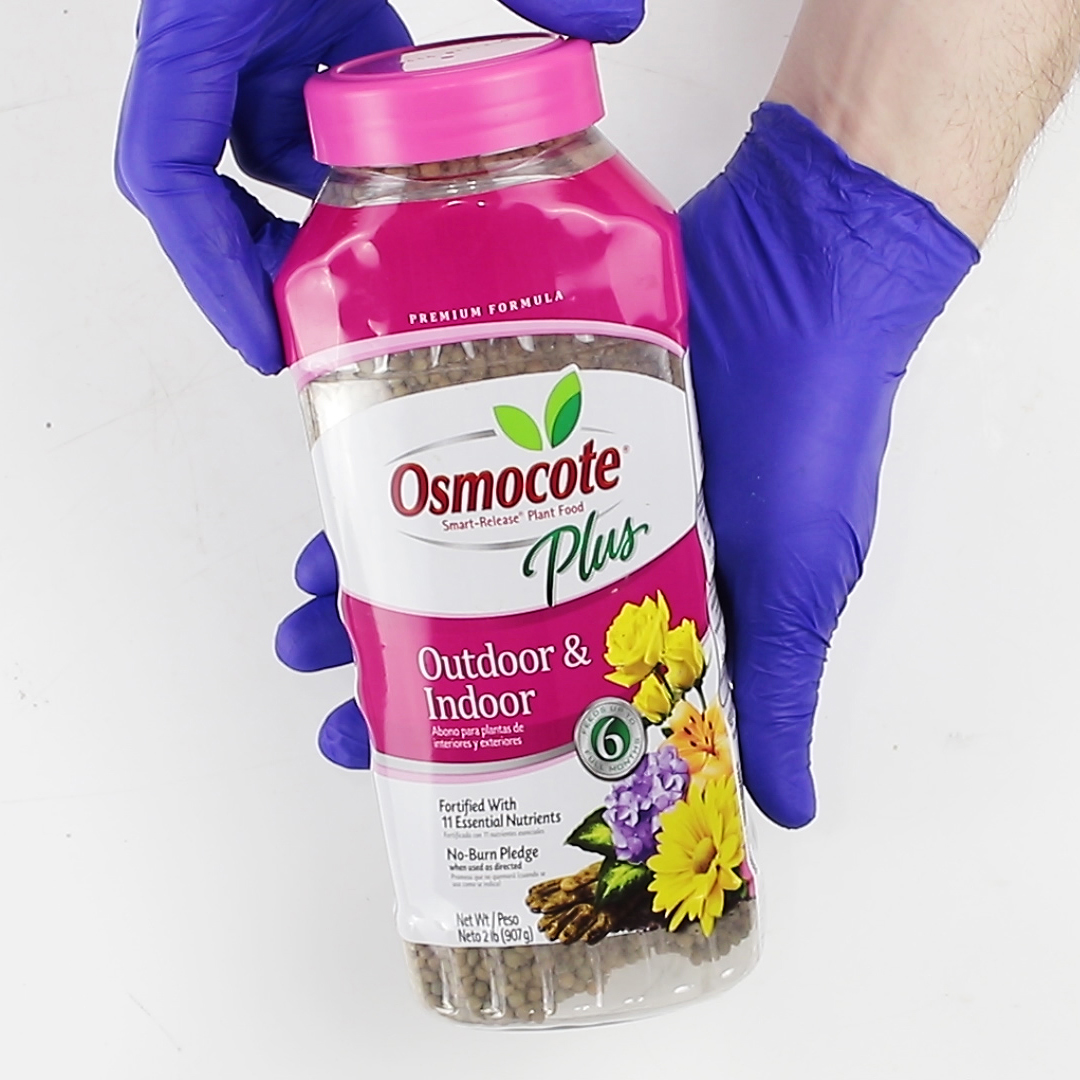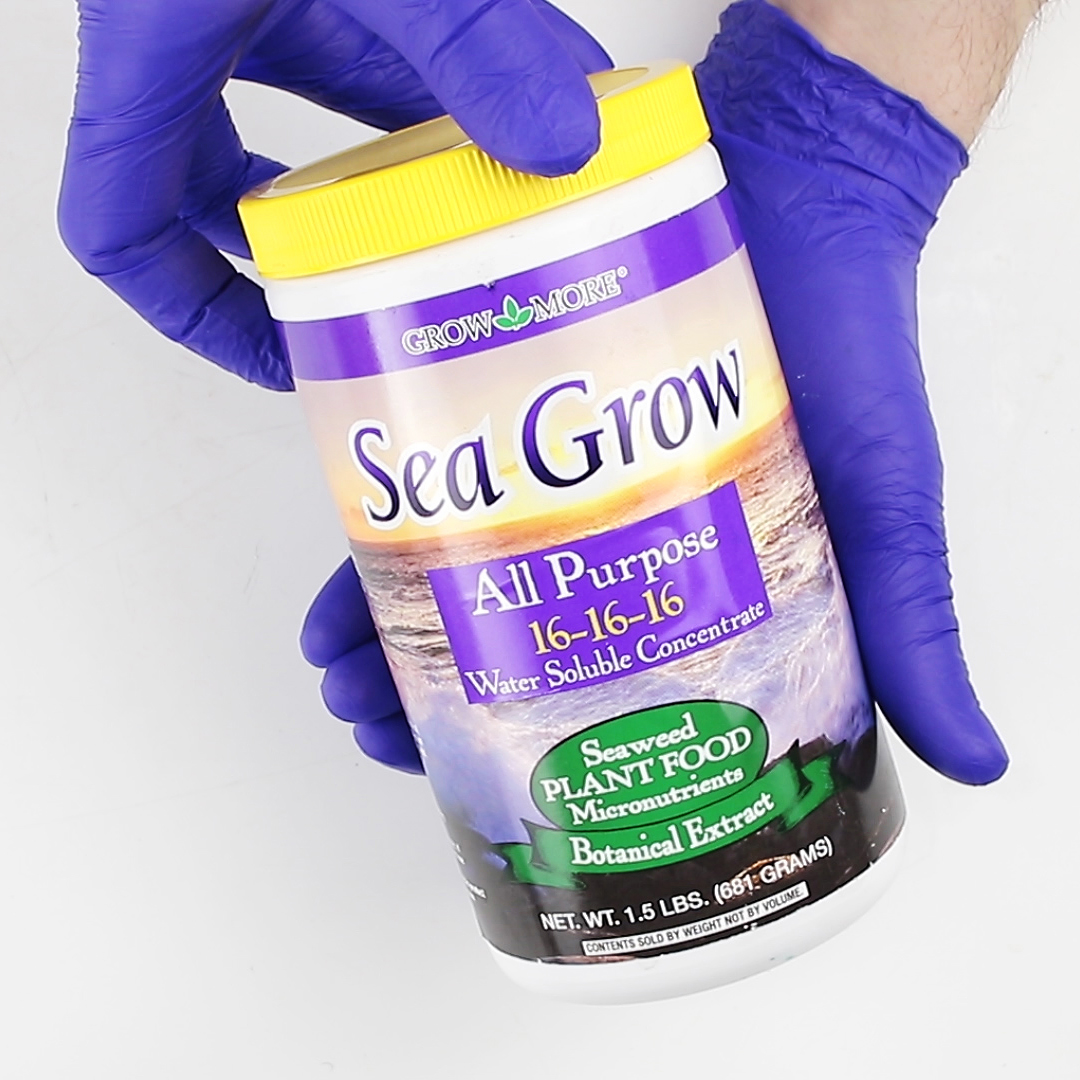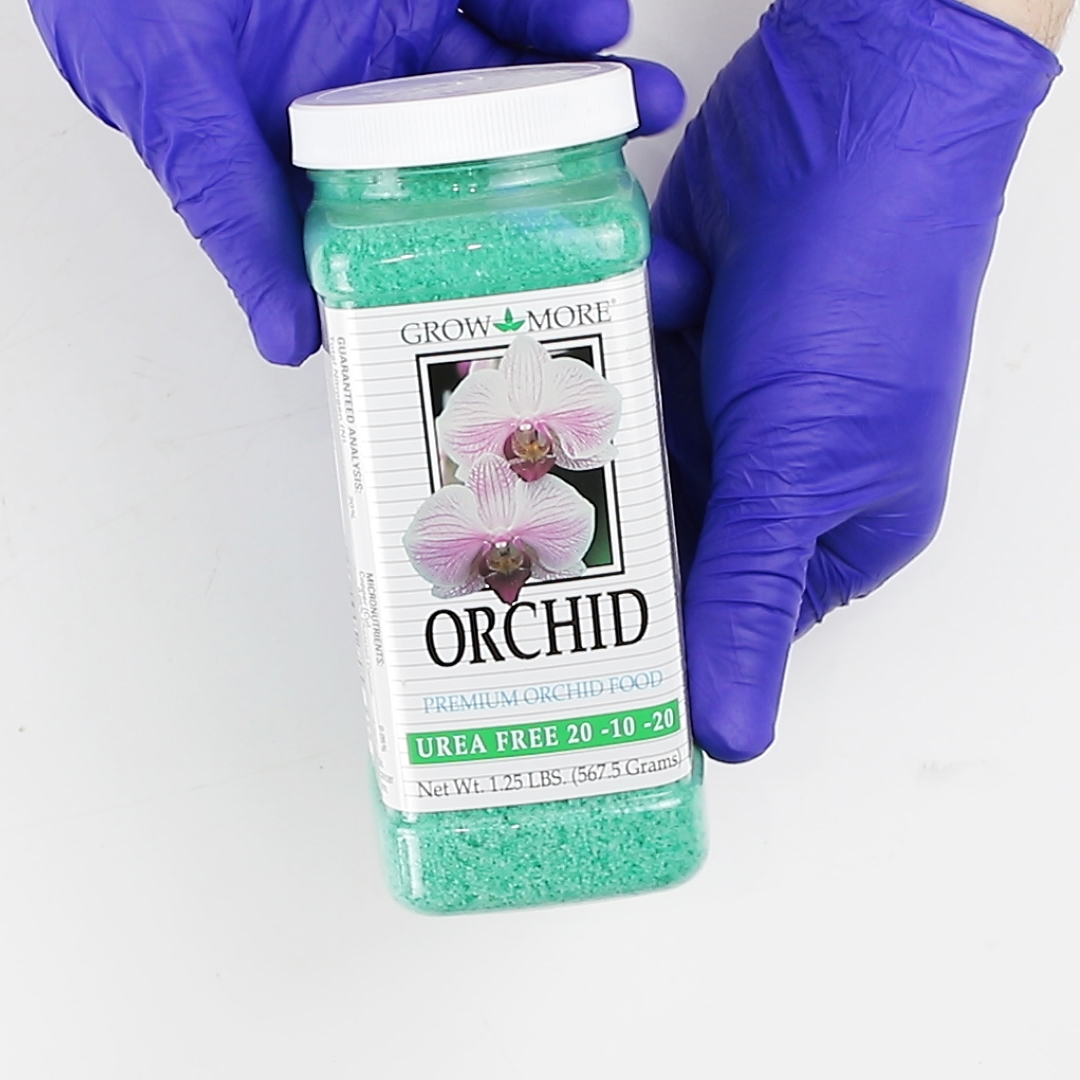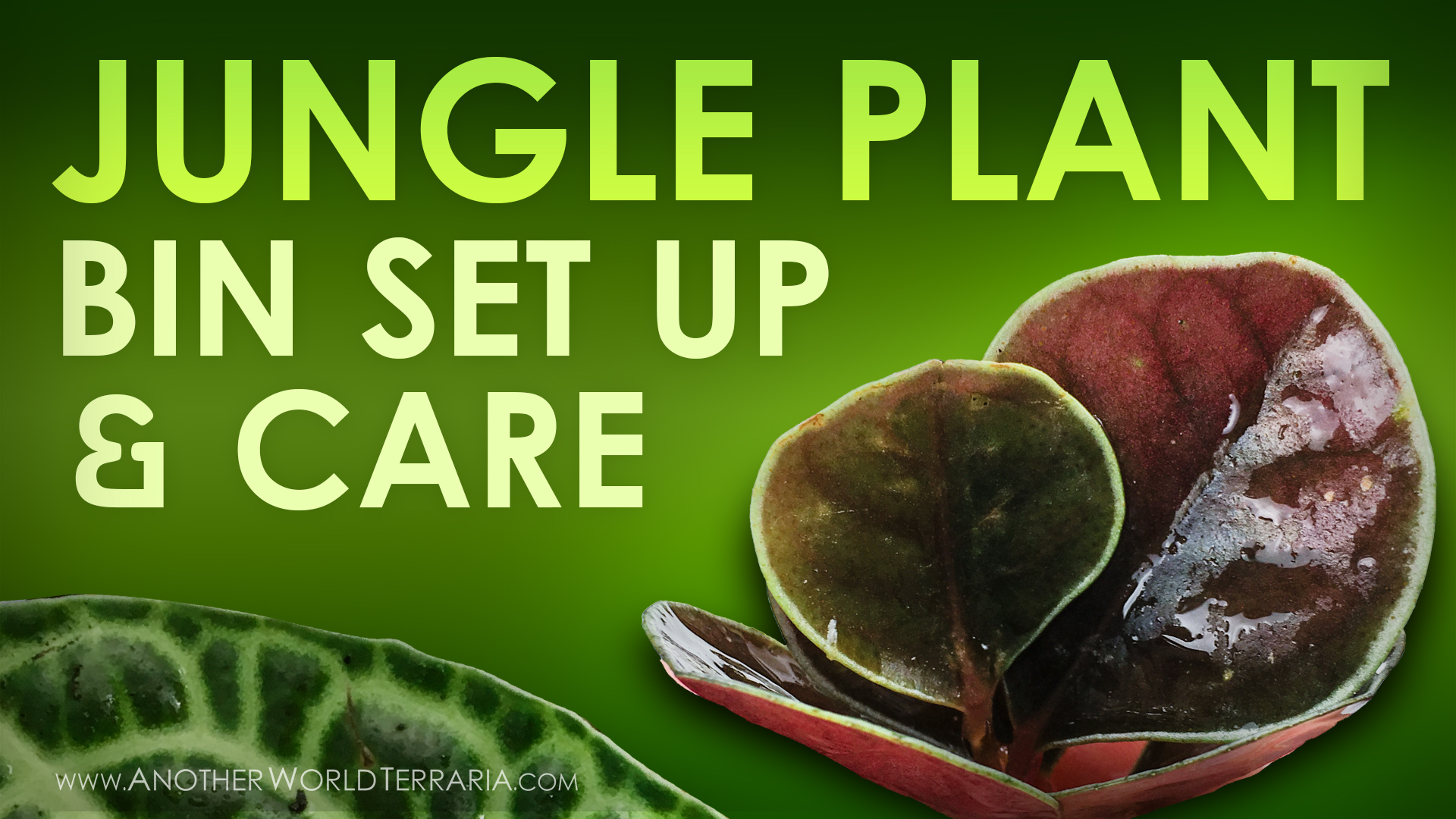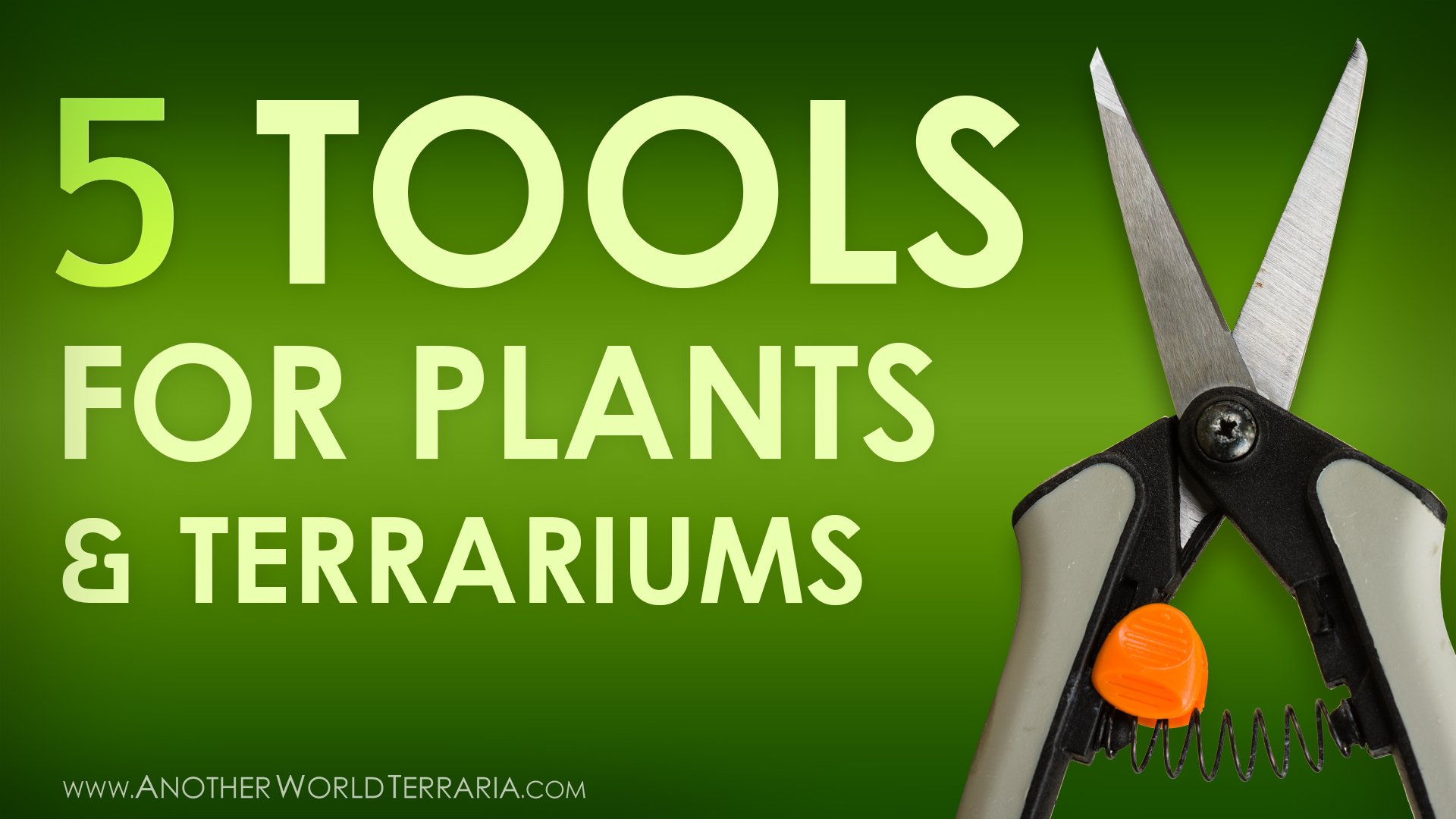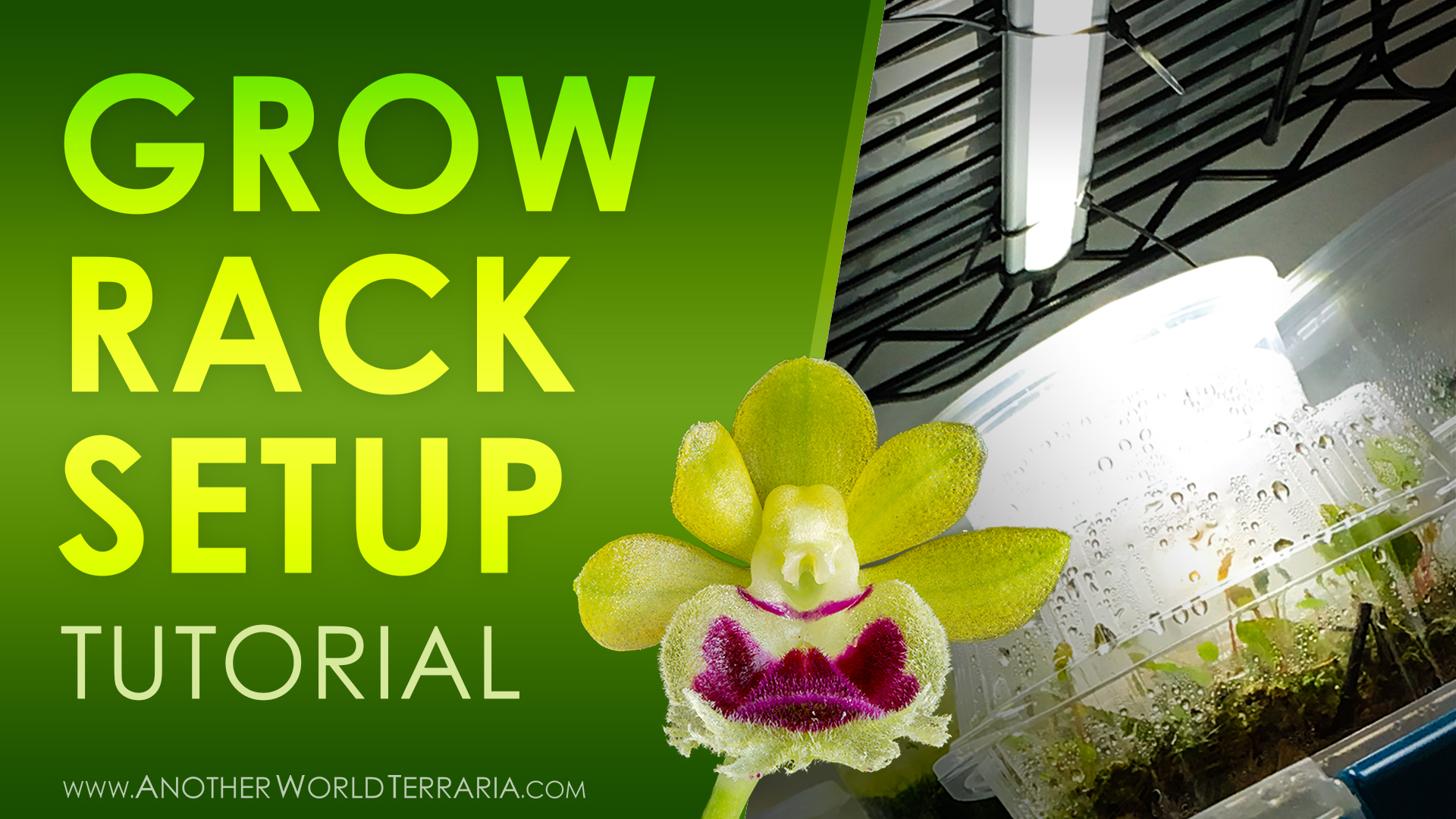Filmy ferns are very enticing horticultural subjects, and are sure to become a weakness of many rare miniature plant addicts. Part of what makes them so alluring is their unique frond shapes and textures, as well as their semi-translucent leaf tissue which makes them look like living gems. Let’s learn more about these amazing plants, and how to grow them….
About Filmy Ferns
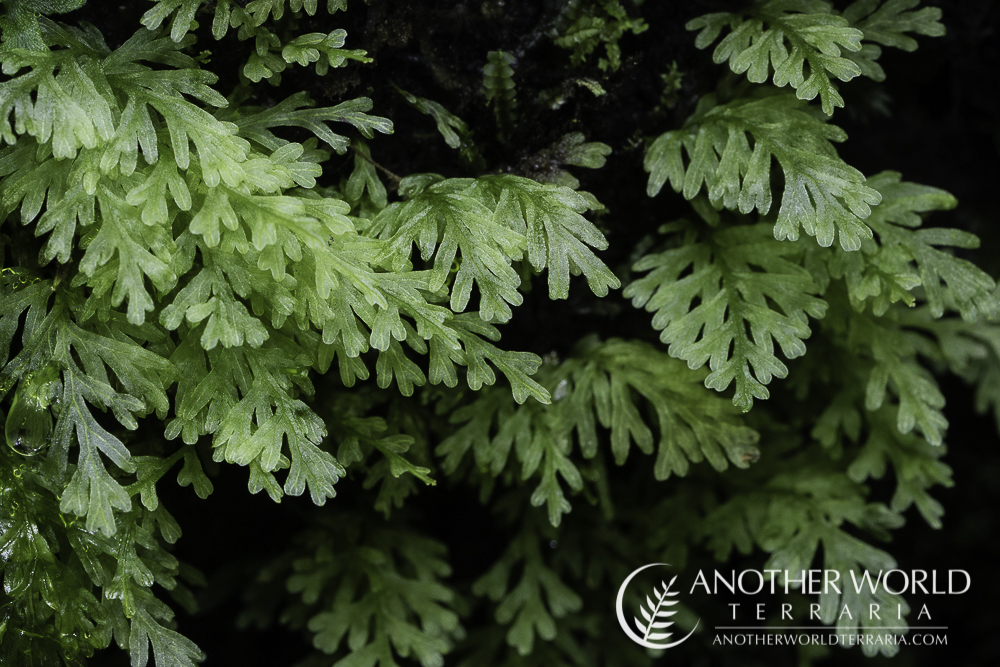
Filmy fern sp. Borneo
Filmy ferns occupy a number of genera in the family Hymenophyllaceae, including but not limited to Hymenophyllum, Trichomanes, and Crepidomanes.
The approximately 650 species are extremely varied in frond form, size, and growth habit. Some species are no larger than ¼” tall, and others have fronds much larger. The fronds may be entire, as a disc or fan, or intricately divided and feathery. Fronds come in a wide spectrum of colors, with most being shades of green, but some may be glaucous (have a dull grayish overtone).
Most have tissue which is only one cell thick, making it translucent to some degree, which is why they are often referred to as “filmy” ferns. As you’ll learn later, the thinness of the fronds is one of the reasons why filmy ferns require special care to grow.
Filmy ferns’ environment is usually very wet, often in cloud forests and fog prone locations, as well as rainforests with significant precipitation, which maintain the humidity levels necessary for their survival.
They usually grow in areas where they are sheltered from dry air, such as pockets of moss, wet wood, and rock crevices.
The plants may also be near splashing, dripping, or seeping water, which supplies constant moisture to their delicate fronds, protecting them from drying out.
How to Grow Filmy Ferns
Here’s everything you need to know about growing these delightful but challenging plants.
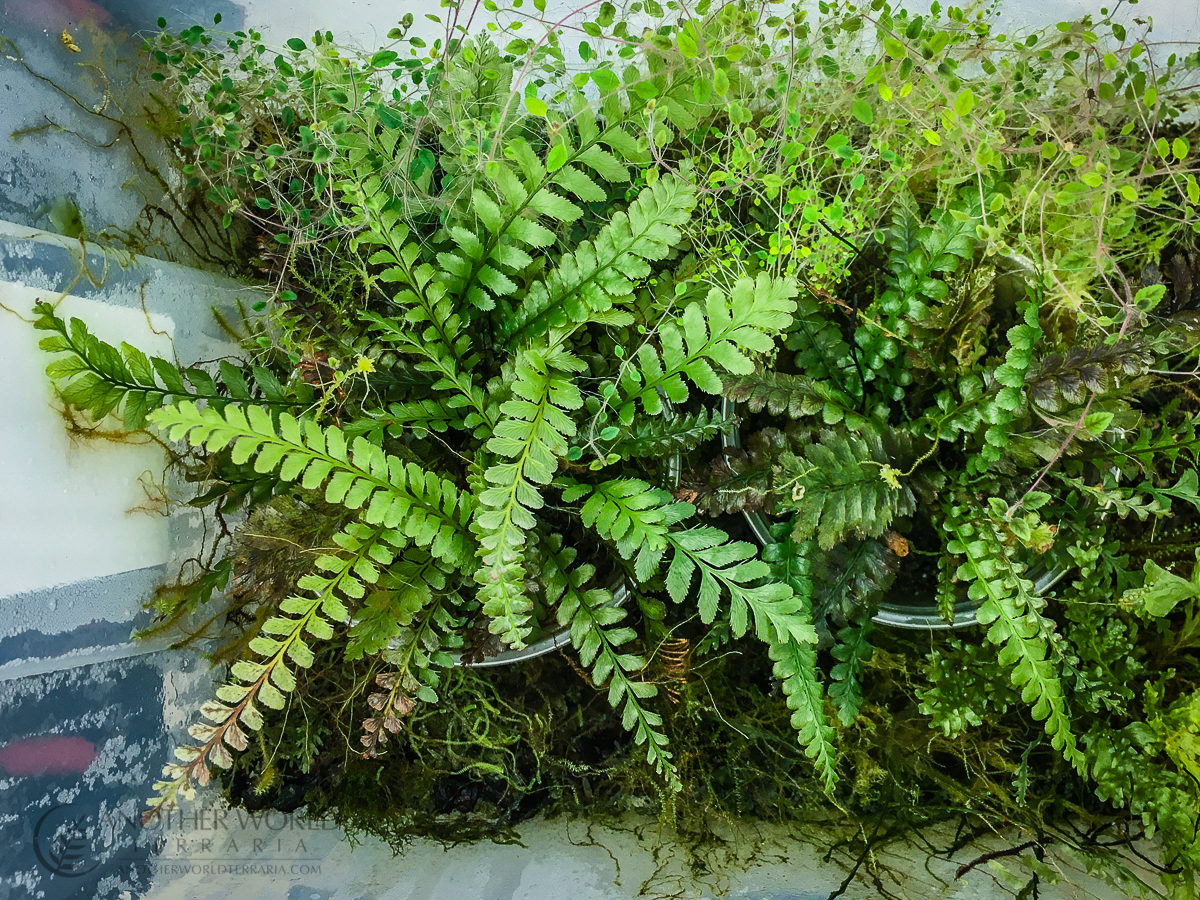
Cephalomanes javanicum in a grow bin
Humidity and Moisture
Filmy ferns require exceptionally high humidity, as would be found in their natural habitat. They have evolved to be adapted to these conditions, which is why their fronds are extremely thin (“filmy”) and have little to no cuticle:
“Hymenophyllaceae are a rare example of an evolutionary shift of adaptive strategy from typical vascular plant adaptation to the poikilohydry most typical of bryophytes.” [1]
In layman’s terms, the quote above means that, similar to mosses, filmy ferns have adapted to utilize their environment as way to maintain tissue hydration, as opposed to having structures or mechanisms for doing so within their foliage.
Since their fronds are so susceptible to drying out in the absence of moisture, you need to keep the humidity extremely high. A Relative Humidity (RH) of 90%-100% is ideal.
Filmy ferns should be kept in very moist or wet conditions, which helps maintain high humidity and can also support tissue hydration by direct contact. Their rhizomes should never be allowed to dry out. They will benefit from frequent misting with pure water, which mimics the rain, mist, and fog in their natural habitat.
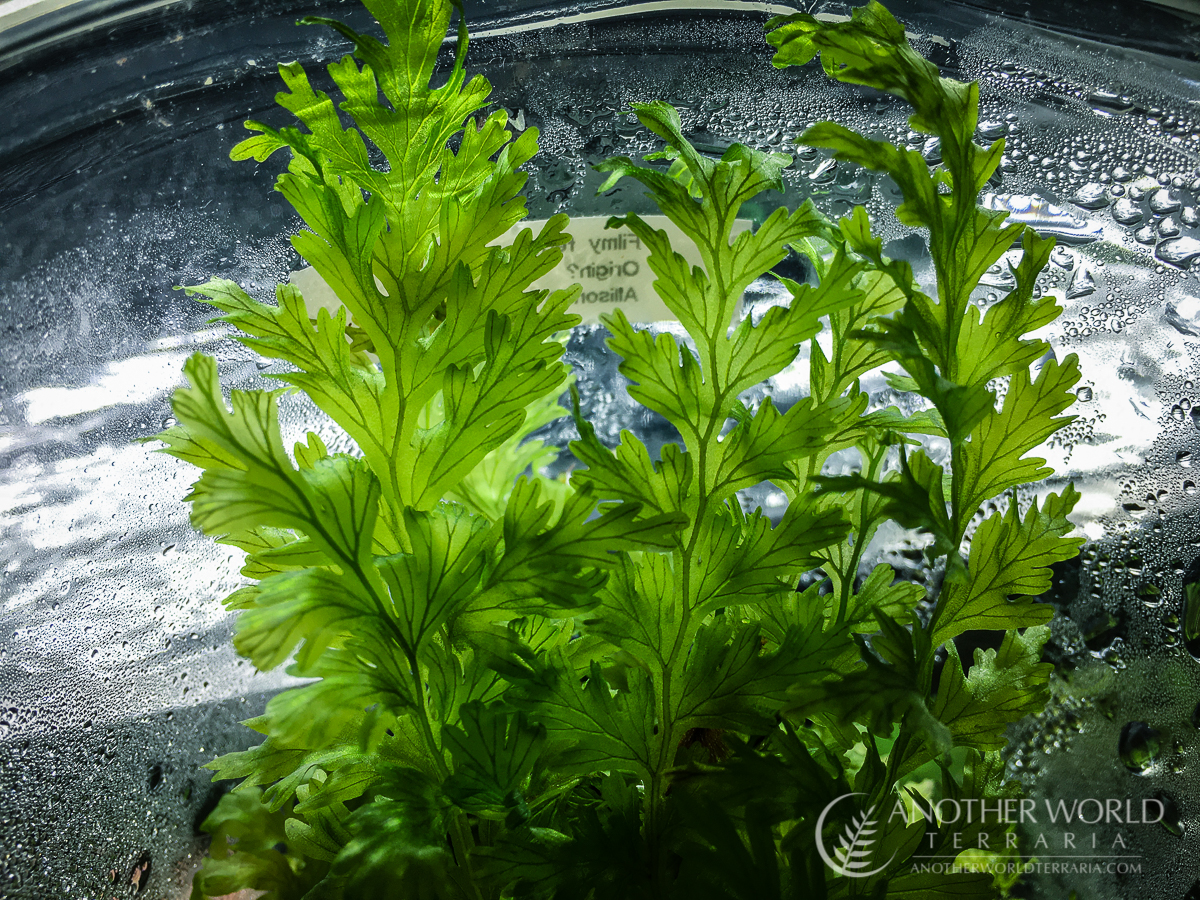
Unidentified filmy fern. Note the condensation on the container, indicating the presence of much moisture.
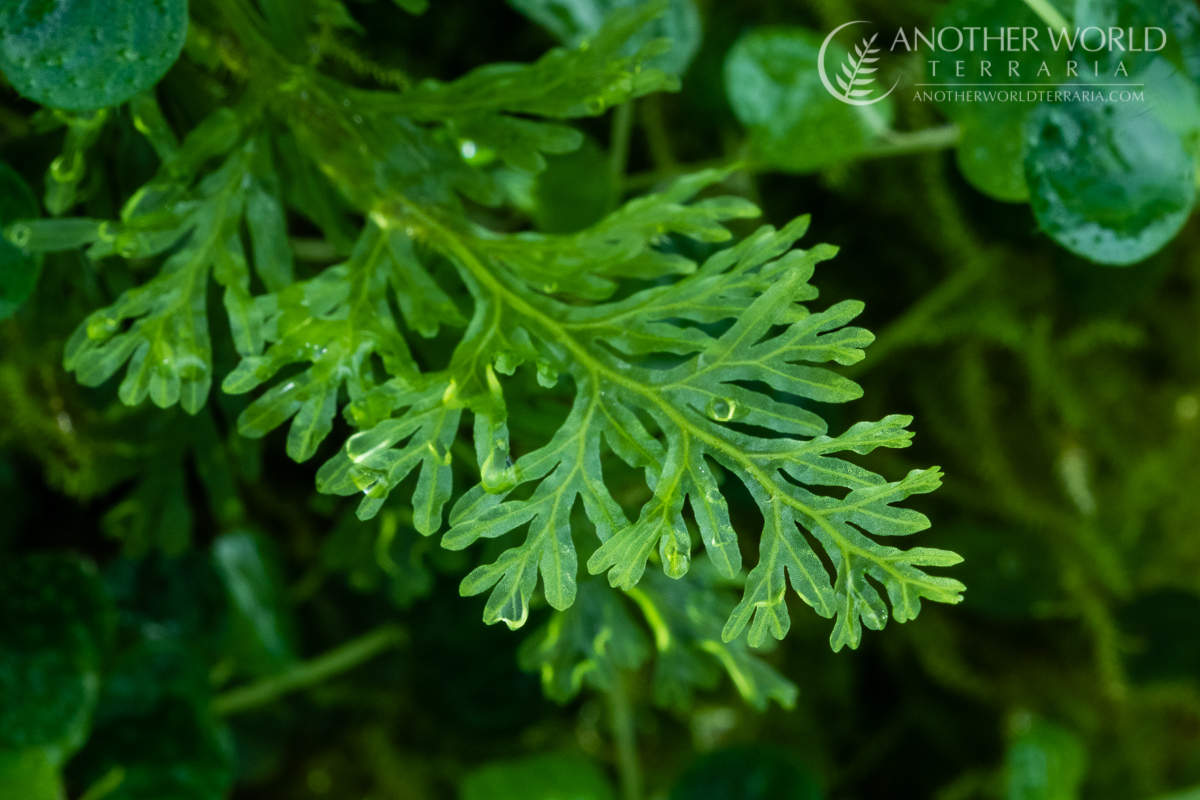
Unidentified filmy fern. Note the thin, translucent frond, susceptible to drying out.
Container
Filmy ferns should be kept in an enclosure which is entirely sealed, to maintain the humidity and moisture they require.
Glass aquariums, jars, plastic bins, and deli cups are good options.
Pro Tip: Even if a container is completely sealed and moist, in hot temperatures it is possible for the substrate and plants to dry out. This can happen because the moisture in the substrate evaporates due to the heat, then condenses on the container lid and walls, leaving the substrate dry. Filmy fern fronds are also directly susceptible to drying out from heat. In very warm weather, or in plant rooms that are very warm on a consistent basis, you should check the substrate moisture levels frequently, and mist the plants more often.
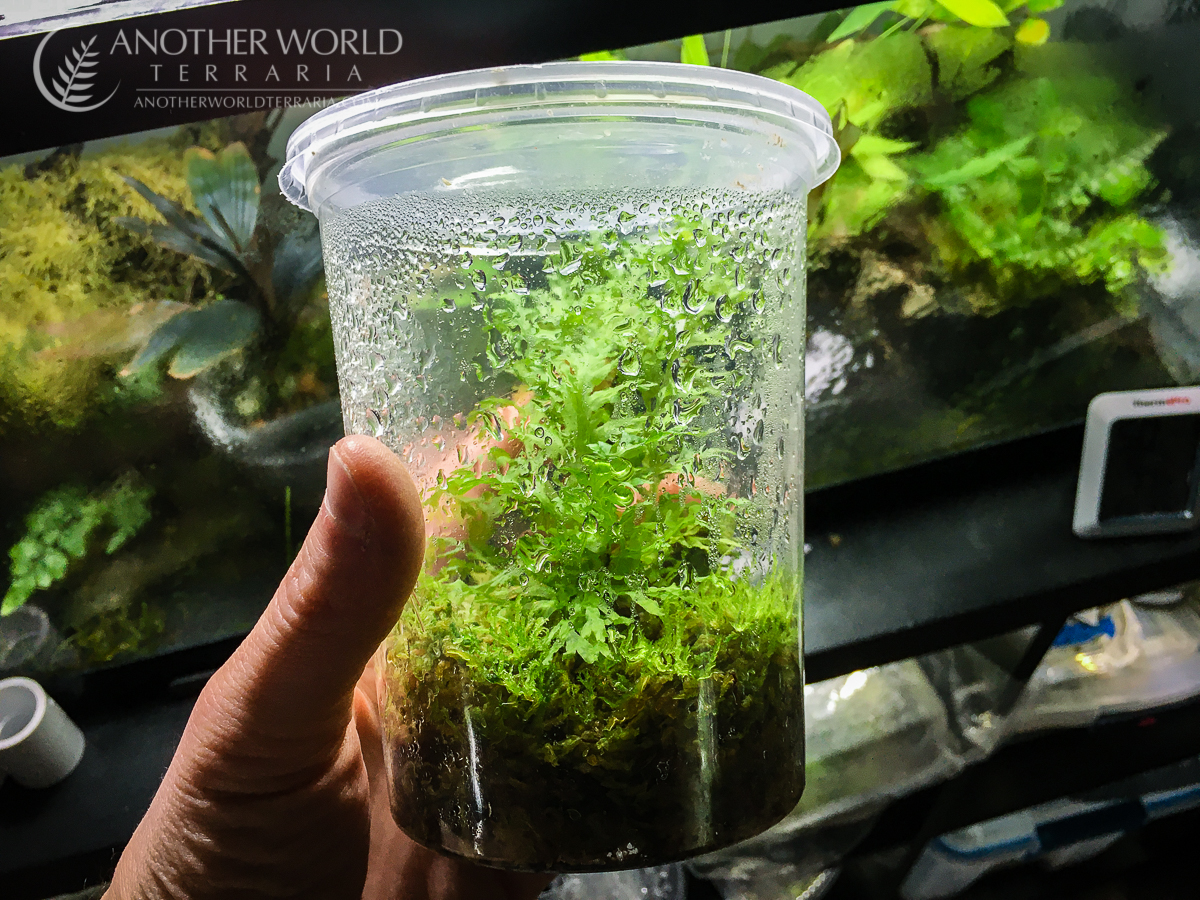
Filmy fern in extremely humid, sealed deli container
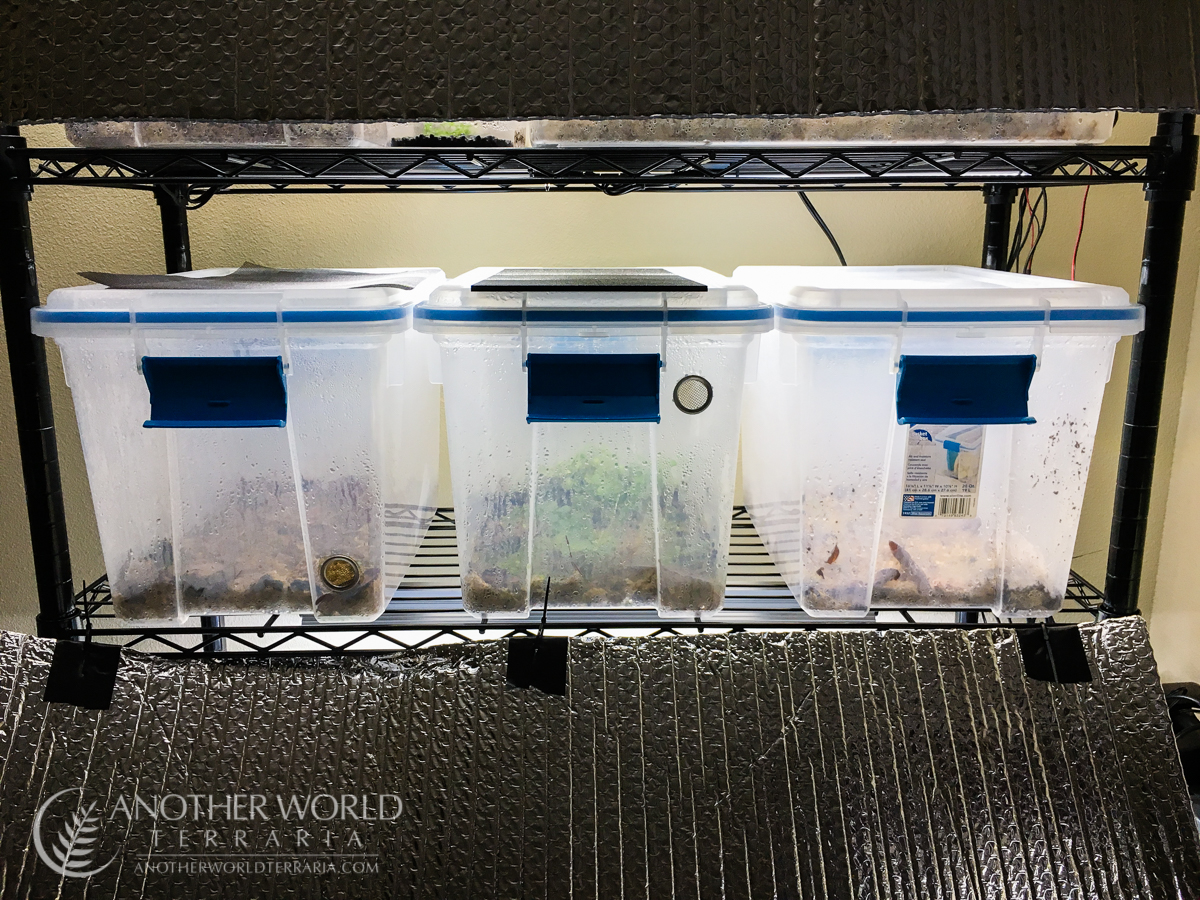
Above is a photo of some grow bins on a grow rack, which work very well for growing filmy ferns. Check out my grow bin tutorial and my how to set up a grow rack series to learn more.
If you’d like to make your own grow bins, check out my convenient grow bin product list on Amazon.
Feel free to browse the containers list on my Amazon page to see a variety of plastic bins and cups that work well for filmy ferns and other tropical plants.
Air flow
When growing filmy ferns, keep air circulation to a minimum or zero, and avoid ventilation completely. (NOTE: the difference between circulation and ventilation is that the former is air movement within the container, and the latter is exchange of air between the inside and outside of the container). Even under humid and wet conditions, sometimes filmy ferns will dry out when exposed to significant air movement, though some species are more resilient than others.
If you’re growing these ferns in a grow tank or vivarium with fans, observe these guidelines:
- Put them as far away as possible from fans
- Shelter them from the direct flow of air, by larger plants, branches, rocks, a plastic sheet or plastic wrap, fiberglass screen mesh, and so on
- Mist them more often (an automatic misting system would be ideal)
- Put the fans on a timer with multiple on-off programs throughout the day, so the air flow isn’t constant.
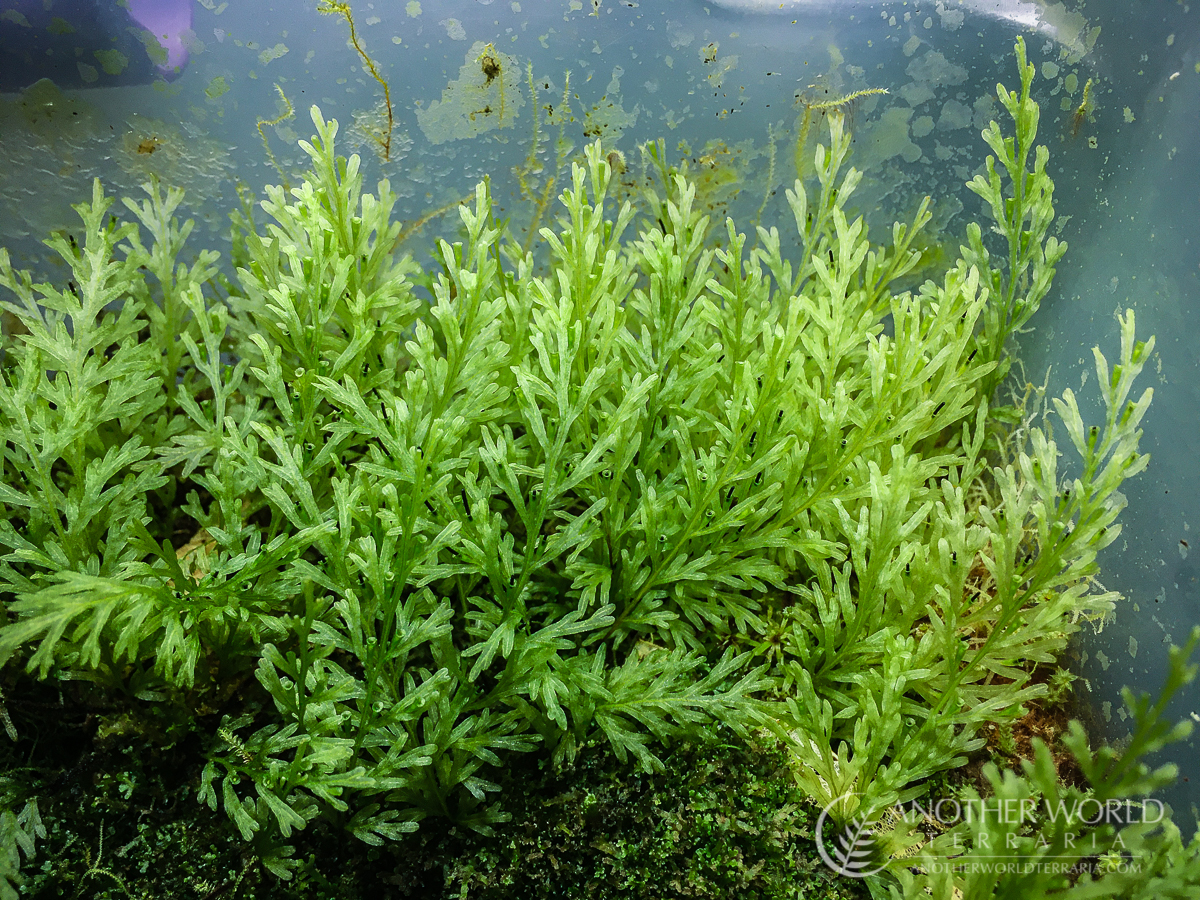
An impressive colony of filmy ferns which took several years to grow in a plastic bin.
Water
For watering and misting, use water that is very pure and low in TDS (Total Dissolved Solids), for example, distilled water or RO water. This mimics the purity of rain and mist from their natural habitat and avoids harming the delicate foliage.
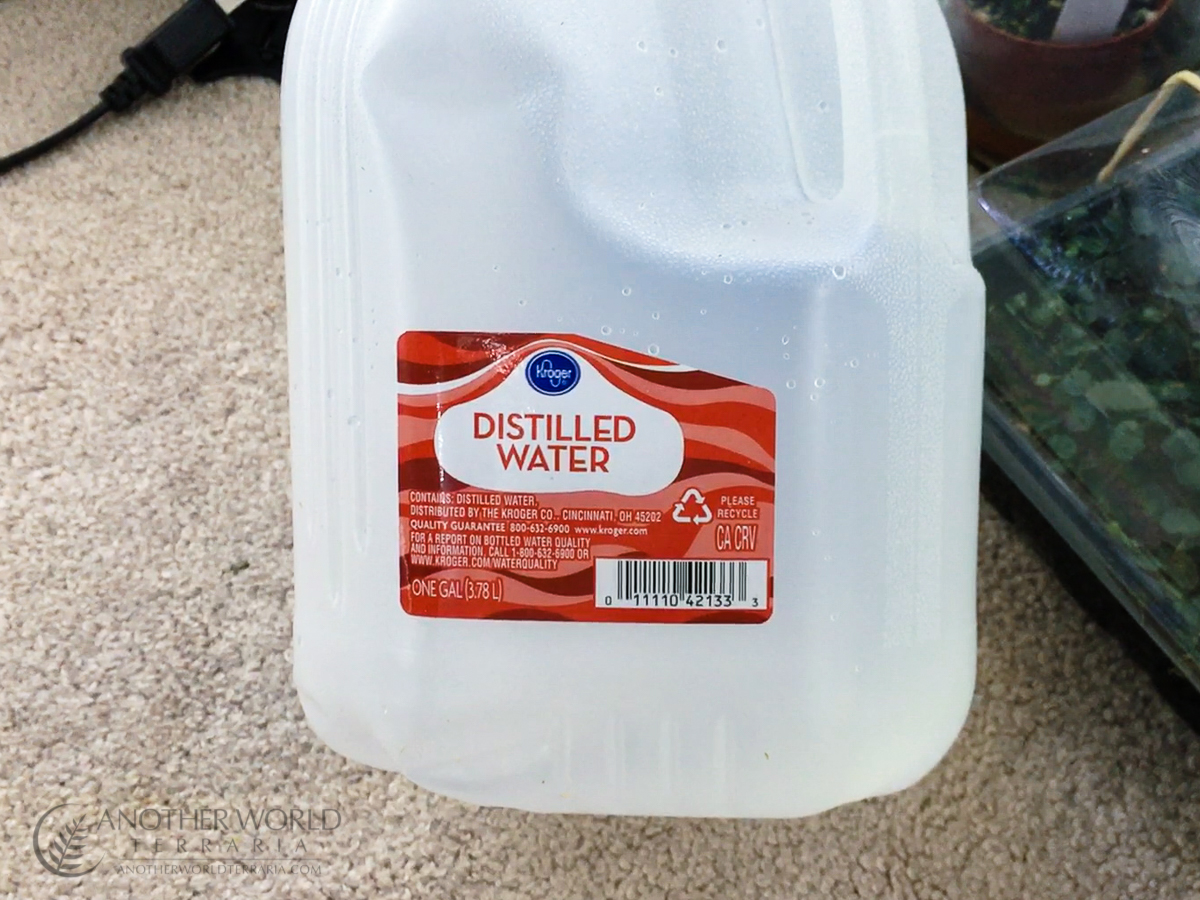
Distilled water
Substrate
The best substrate will depend on the natural habitat of each species. In many cases Sphagnum moss will work well, and is what I use most often. Other options you can experiment with are bark, soilless mixes, rocks, and branches. The rhizomes should be planted in contact with a moist surface (that said, sometimes a filmy fern rhizome will begin to grow off the surface if the humidity and moisture are near 100% and the plant is happy – as long as it’s the plant’s choice, it shouldn’t be a problem).
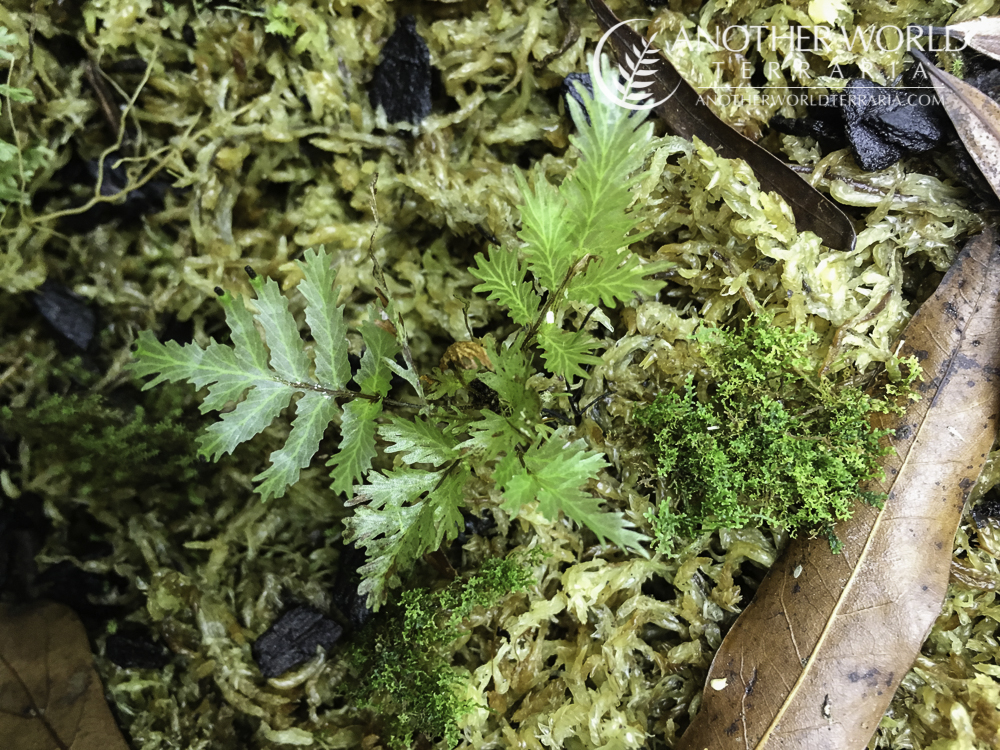
Unidentified filmy fern growing in a mix of Sphagnum moss, Pinus radiata bark, and Willow Oak leaves
You can browse the substrates list on my Amazon page to see the Sphagnum that I use, as well as other substrates that I use for my plants and terrariums
Placement
In general, filmy ferns should not be planted in open spaces that are exposed to air movement, very bright light, or low humidity levels. They should be placed in sheltered locations where wood, rocks, moss, larger plants, and other things will protect them. The more sheltered you can make them, the happier they will be.
Many filmy ferns will enjoy growing near (or sometimes in) water features, such as waterfalls, pond banks, and drip walls, where the rhizomes and fronds will receive constant moisture and humidity. Note that the degree of wetness a filmy fern can stand will depend on the species and how they grow in the wild. Some will do better when very wet, others prefer to be slightly moist. Also be aware that extremely wet conditions can lead to increased mold, algae, and decay.
Above is “The Cliff” drip wall tank, which has a background made of feather rock. Running water trickles down the rock face for several hours at a time, twice a day. There are a few different species of filmy ferns growing in the tank, including one from Borneo (close up photo above) which does very well on the vertical rock surface. There are also fans in the tank which help reduce mold, but as suggested in this article the fans turn on and off many times per day as opposed to running constantly. This gives the filmy fern fronds a chance to rehydrate.
Filmy ferns can be grown on horizontal or vertical surfaces, though each species may have a preference. Keep in mind that vertical surfaces are more challenging to keep saturated, as the moisture runs downward. The more moisture-holding substrate you can use on the surface, the better. For example, wrapping Sphagnum around a branch, or using Hygrolon fabric glued to a rock. Another way to grow filmy ferns on vertical surfaces is to create a drip wall, with a water pump, as shown above in The Cliff drip wall terrarium.
Lighting
Bright light should be avoided for filmy ferns.
“Light and desiccation responses of filmy ferns can be seen as an integrated package. At low light and windspeed in humid forests, net radiation and saturation deficit are low, and diffusion resistance high. Water loss is slow and can be supported by modest conduction from the sub-stratum.” [1]
The technical jargon quoted above can be translated loosely into layman’s terms to mean that lower light environments are more supportive of keeping filmy ferns hydrated.
Medium to low light, and indirect light, are ideal for many species. Extremely dim light is acceptable for some, but growth will probably be substantially slower than in higher light levels.
You can control light levels by:
- choosing light bulbs with different specifications
- adjusting how far the lights and plants are from each other
- using shade materials such as fiberglass window screen, shade cloth, or even just a sheet of paper
- placing the plants in sheltered locations under branches or larger plants
Above: One way to reduce light levels is by adding one or more layers of fiberglass window screen over the plant container.
By the way, I have a video that shows and discusses the lights I use for my plants.
Temperature
Since filmy ferns grow in many different climates (see range map, below), there is not one global rule for temperature. Some prefer to be on the cool side, while others will do just fine in warm temperatures, and a few species may be able to survive hot temperatures, all assuming the humidity is adequate and the lighting is dialed in correctly.
If you know where a particular species came from, you can do some research to identify the ideal temperature ranges. When in doubt, intermediate temperatures are a good starting point.
In general, you’ll want to avoid hot temperatures, unless a species is adapted to that. In hot climates or hot weather spells, you may want to keep filmy ferns in the coolest part of your home (basement, closet, air conditioned room, and so on).
Also note that the hotter the temperatures, the more often you’ll need to mist the plants and check that the substrate is still moist.

Hymenophyllaceae occurrences world map
Filmy ferns grow across the world in a variety of climates.
Source: GBIF.org
Submersed growth
Some species of filmy ferns grow in areas where water is constantly flowing near or over the plant, or where the plant is seasonally flooded, therefore you can experiment with growing them submerged in water.
It’s important to use pure water, and to ensure it is fresh and doesn’t become full of algae. Do water changes to maintain the quality.
Some species may benefit from water movement from a pump or filter.
If the species is suitable for growth under water, within a few weeks to a few months you should notice healthy new growth of rhizomes, and newly forming fronds. Aquatic leaves will sometimes be morphologically different from emersed leaves, and will die if taken out of water long enough to dry out completely.
Growing filmy ferns in water is a fun experiment, and when successful it results in beautiful and interesting growth. I’ve found that the growth rate under water is significantly faster than in terrestrial conditions.
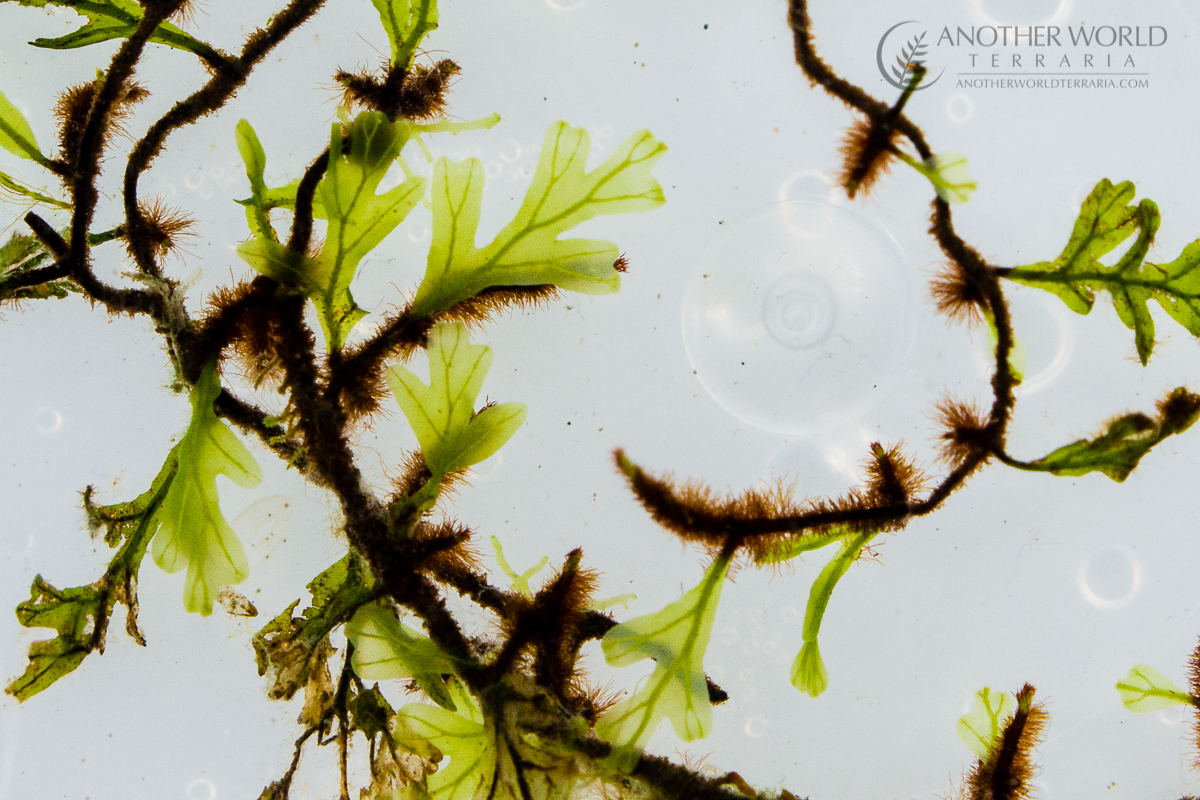
Filmy fern grown submersed (under water).
Fertilizer
Filmy ferns generally have low nutrient requirements, but you can get slightly faster and more luxuriant growth by fertilizing them.
When I first started growing these ferns, I thought they were incredibly sensitive and would die (or the fronds would be damaged) if fertilized. Over time, I have experimented and found them to handle fertilizer as well as many of my other plants, however some species are more sensitive than others, and there are some caveats noted below.
The following are very important:
Form of fertilizer (liquid vs solid)
Liquid and solid fertilizers can be used, however solid are more risky when it comes to filmy ferns due to the chance of burning if applied to the foliage, and in general due to the fact that they deliver stronger doses.
Dose strength (dilution level)
The lower the dose, the safer it will be. I like to dilute liquid fertilizers to 1/4 strength. When using solid fertilizer, I use very few pellets.
Method of application (foliar vs root level)
Extremely diluted liquid fertilizers may be applied by misting the foliage, however do this with caution at first by testing a few fronds and waiting a few weeks. Solid fertilizers (pellet form, for example) should be applied at the roots and never onto the foliage.
Frequency of application (every watering vs occasional)
The more diluted the fertilizer is, the more often it’s OK to apply, however I would not recommend fertilizing more often than once every few weeks.
Testing
For all fertilizers, start with very low doses, and, if possible, test on a a few fronds, a small section of a clump, or a plant division. If the test plant remains unharmed after several weeks, it should be OK to apply a little more fertilizer, or to a larger section of the plant.
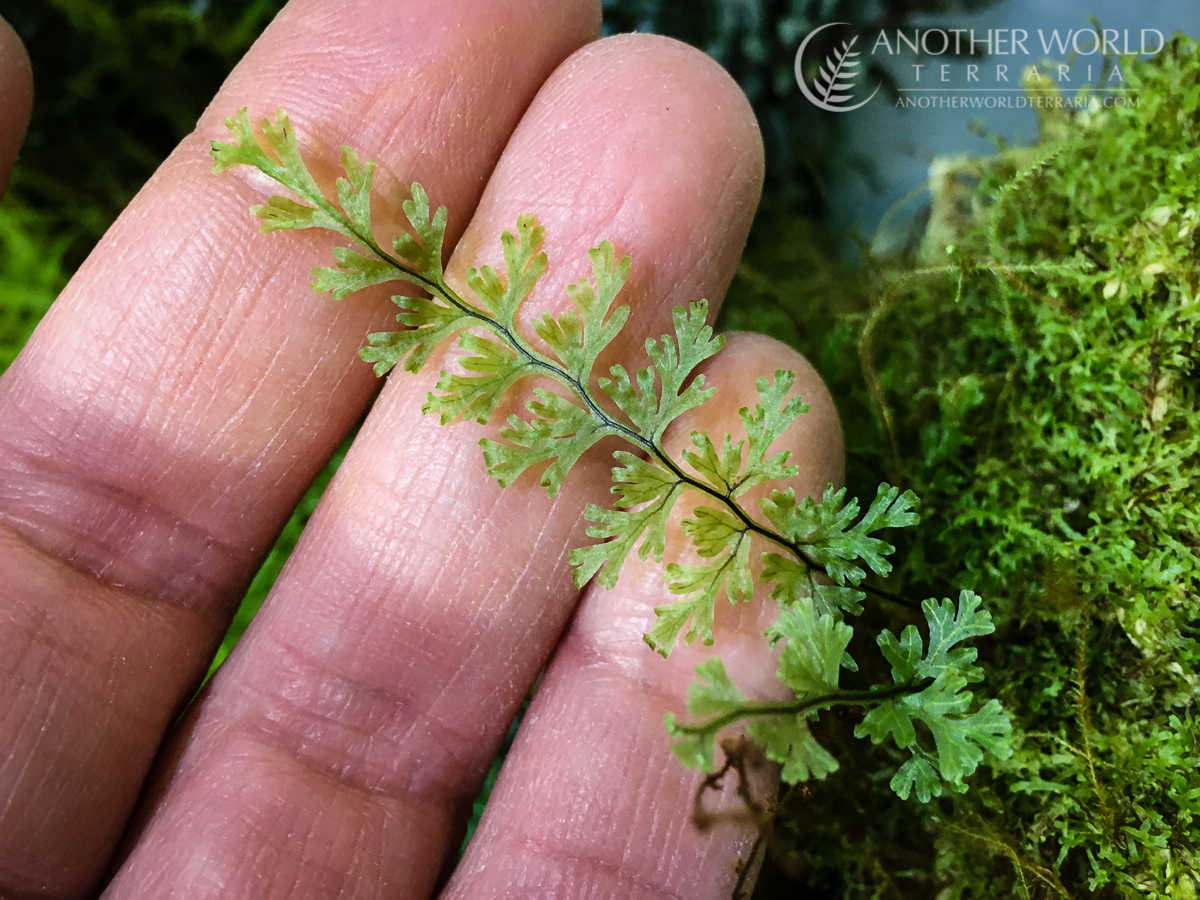
Some fertilizers I have used for filmy ferns are:
Grow More and Sea Grow
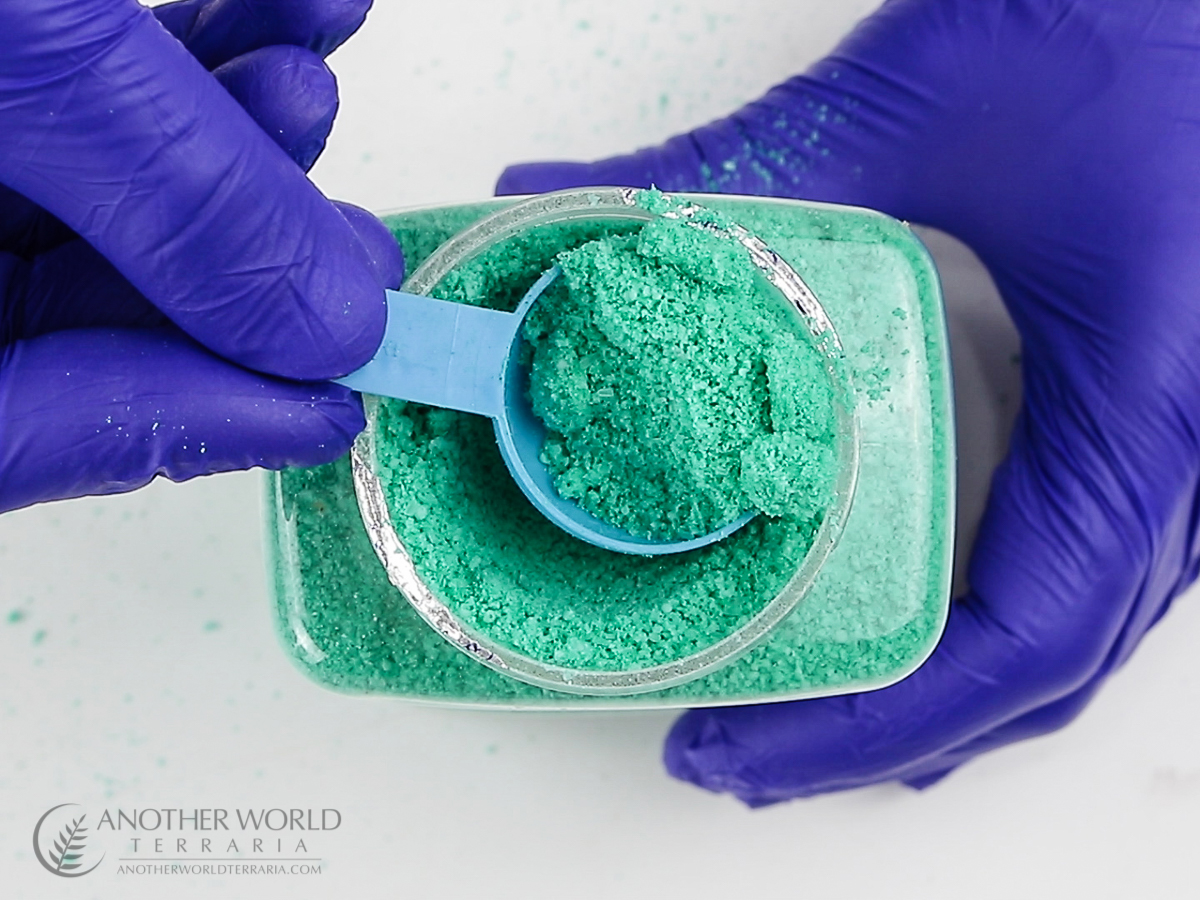
Grow More Urea-Free orchid fertilizer
These fertilizers come as a granular powder which must be mixed with water (distilled or RO), to about 1/4 of the strength recommended on the packaging. Use a spray bottle to gently mist the plants once a month.
Osmocote Plus
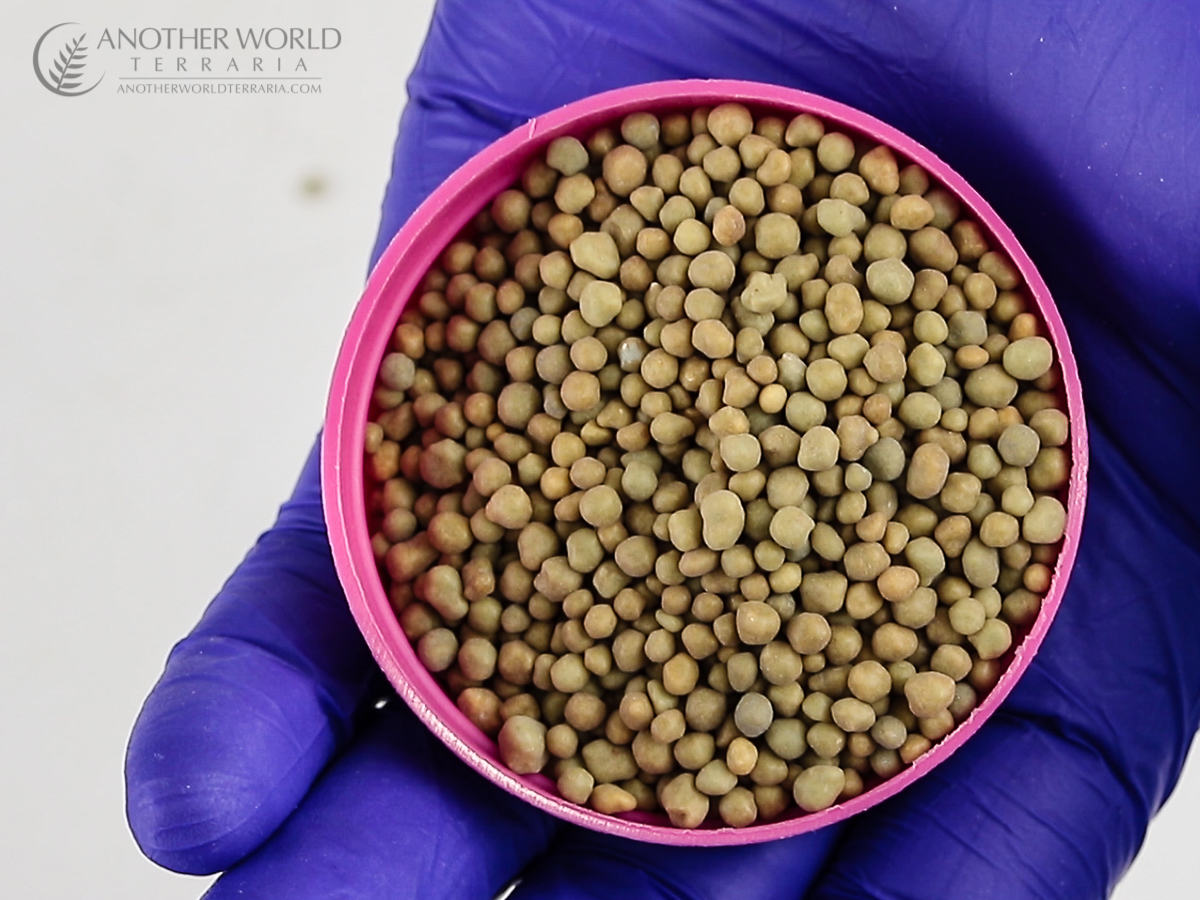
Osmocote Plus
Osmocote Plus is a slow-release capsule. The fern size and species will affect how much fertilizer you apply, but in general use about 1 capsule per 16-25 square inches (4″ – 5″ square area) of fern clump. The capsules should release nutrients for 3-6 months.
Important notes:
- Never apply Osmocote or any other solid fertilizer direct onto the fronds of filmy ferns, as this can cause burning and death of the foliage or possibly even the entire plant in some cases. Instead, apply the capsules near the roots of the plant, at the substrate surface or just below it.
- Osmocote is slightly riskier than using a diluted liquid fertilizer, because Osmocote results in greater concentrations in centralized areas, which could overwhelm or burn very sensitive species.
- Osmocote and other solid fertilizers should be applied much less often than liquid fertilizers
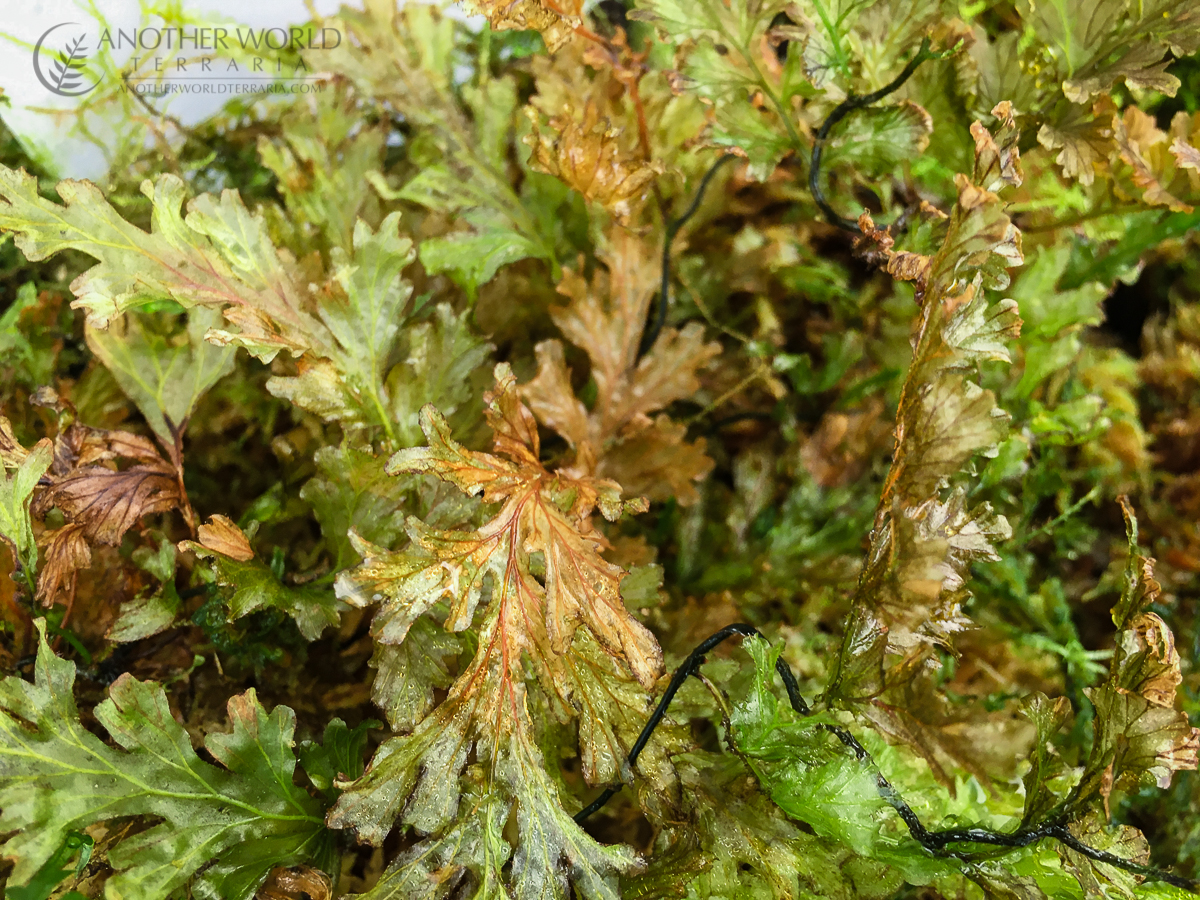
Fertilizer burn caused by an Osmocote pellet sitting on a frond (pellet was removed prior to taking photo)
Salts and chemicals from fertilizers can build up in the substrate over time, therefore I recommend to:
- fertilize in low doses and not too frequently
- change substrate when it gets really old
- in growing situations which permit it (culture in a pot or on a wood branch, for example), water heavily on occasion to flush the salts away
Excess nutrients can lead to algae growth in the moist conditions where filmy ferns grow. Most of the time it shouldn’t be a serious issue, especially when growing plants in low light levels.
See my plant fertilization video for more info, and pick up some of my recommended fertilizers on Amazon.
Moss and other Plants
Overgrowth of moss and other plants
You will need to protect micro species of filmy ferns from being overgrown by mosses and other plants. Medium-sized to large-sized filmy fern species should be OK with moss growth.
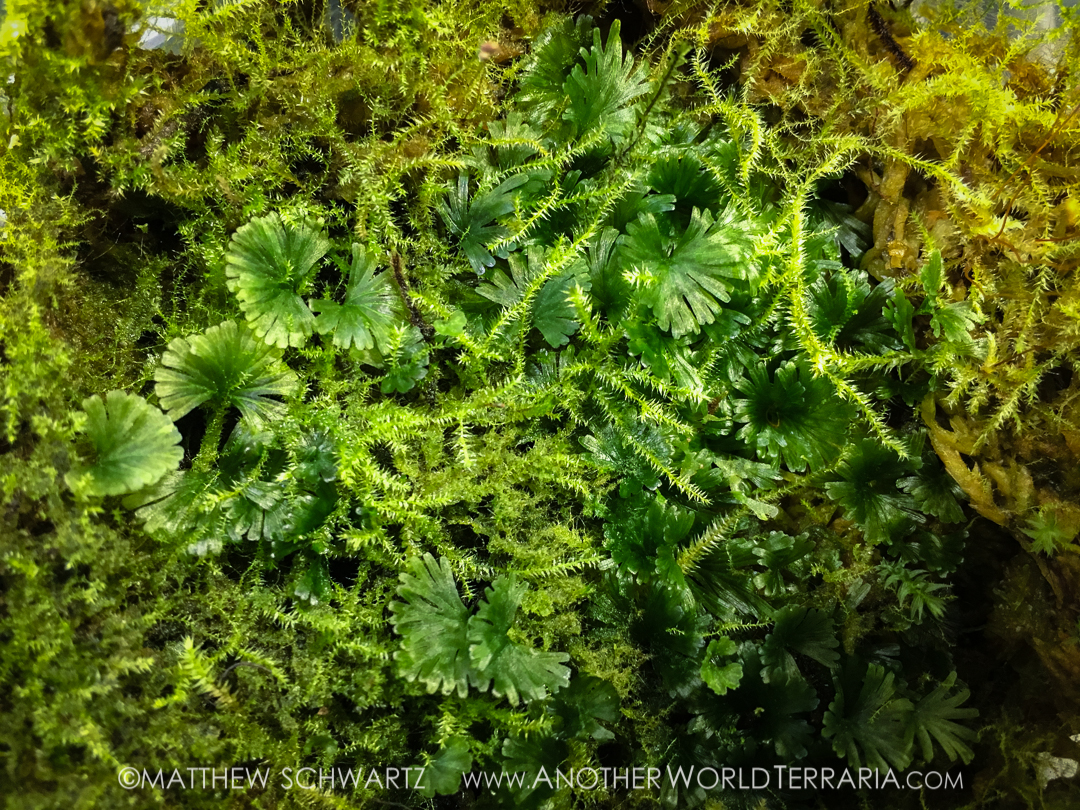
Above: Keep an eye on moss and other plants which can smother tiny species of filmy ferns, such as this Crepidomanes minutum.
Filmy fern companions
There are many other plants which will grow in the same conditions as filmy ferns – of course they typically come from the same or similar habitats. Some examples are:
- Some species of Selaginella
- Some species of Begonia
- Some other tropical fern species
- Tropical moss and liverworts
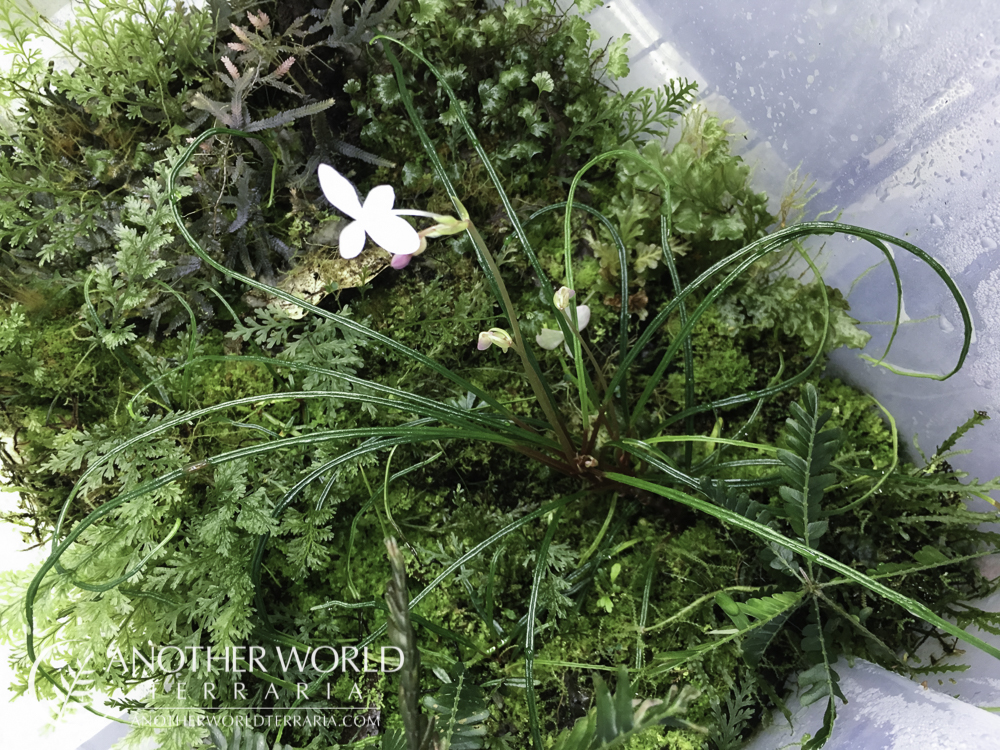
Above: Begonia bogneri, Biophytum sp., and Selaginella sp. growing in a filmy fern bin
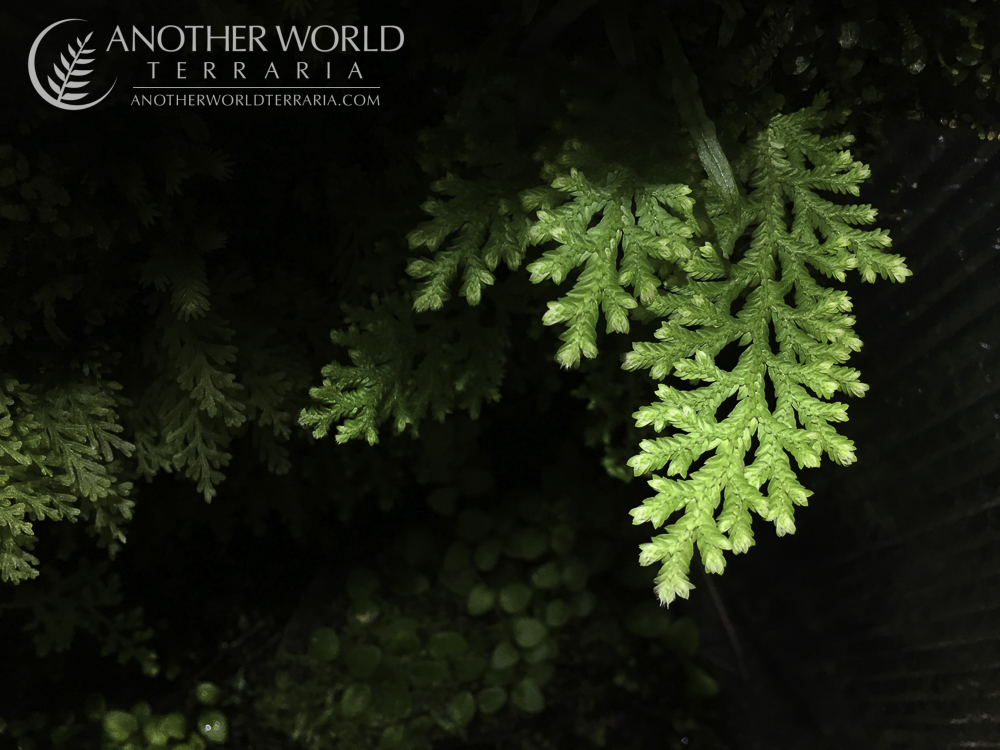
Above: Selaginella sp. White Peru growing in The Cliff drip wall terrarium with filmy ferns.
Filmy Fern Growth Rate
Many filmy ferns are slow (or even extremely slow) growing, so patience will be necessary. As long as the rhizomes stay healthy, and proper conditions are provided, they should plod along at their own pace.
When newly planted, they often take a long time to acclimate (weeks or months). After that, if no growth is seen, but rhizomes are healthy, try slightly increasing the light, humidity, moisture, or nutrients. It is advisable to alter only one condition at a time, to avoid shocking the plant with too many changes at once, as well as so you can track how each individual change affects the plant.
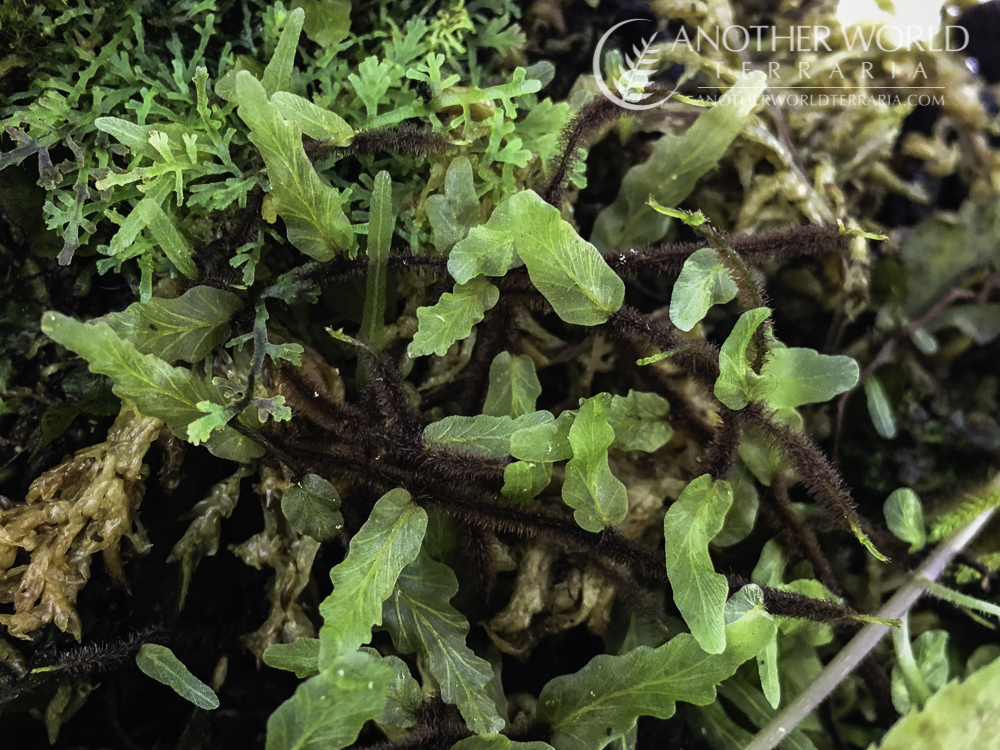
Didymoglossum sp.
Possible Problems with Filmy Ferns, and Their Causes
Fronds are turning a shade of black or brown, or have dark edges or patches.
Some possible causes:
- The humidity and moisture are too low
- There is too much air movement
- The temperature is too high
- The light is too bright
- A harsh fertilizer or chemical has been applied
- Inappropriate water was used (tap water, hard water, water with chemicals, etc)
- The fronds are old and are naturally dying as the plant puts out new growth.
Rhizome tips are no longer green, or rhizomes are dying
Some possible causes:
- The humidity and moisture are too low
- The rhizomes were allowed to dry out
- There is contamination from chemicals, pathogens, mold
- The substrate is too far degraded
- Inappropriate water was used
The plant is alive and healthy, but isn’t growing
Some possible causes:
- The plant needs more time to acclimate
- There isn’t enough light
- The plant needs more water
- There aren’t enough nutrients
There is mold on the substrate or otherwise in the container
Note that mold grows well in very wet and humid conditions, and therefore it is a common problem when growing filmy ferns. Most molds will not cause too much harm. Some more aggressive molds can smother and cause damage and decay.
Some possible causes:
- The substrate is degraded and decaying
- There is other decaying matter (dead foliage, dead rhizomes, etc)
- The substrate is too wet
- Temperatures are too high
- Ecosystem is out of balance
Treatment for mold:
- Replace the substrate when it breaks down and begins to mold
- Remove dead leaves, rhizomes, and other decaying matter
- Reduce substrate wetness
- Reduce temperatures to slow the mold growth
- Add microfauna, such as Dwarf White Isopods (Trichorhina tomentosa) and Springtails (Collembolla species)
Dwarf White Isopods (Trichorhina tomentosa) – a beneficial fauna which eat decaying matter, helping to reduce mold and other problems
Quick Summary
About Filmy Ferns
- Come from very humid and wet habitats
- Slow growing
Filmy Fern Care
- Require extremely high humidity and moisture
- Grow in sealed container, avoid ventilation / air flow
- Use pure water (Distilled or RO)
- Grow in Sphagnum moss, wood, etc.
- Put in low light, sheltered
- Cool to warm temps depending on species
- Low dose fertilizer
Conclusion
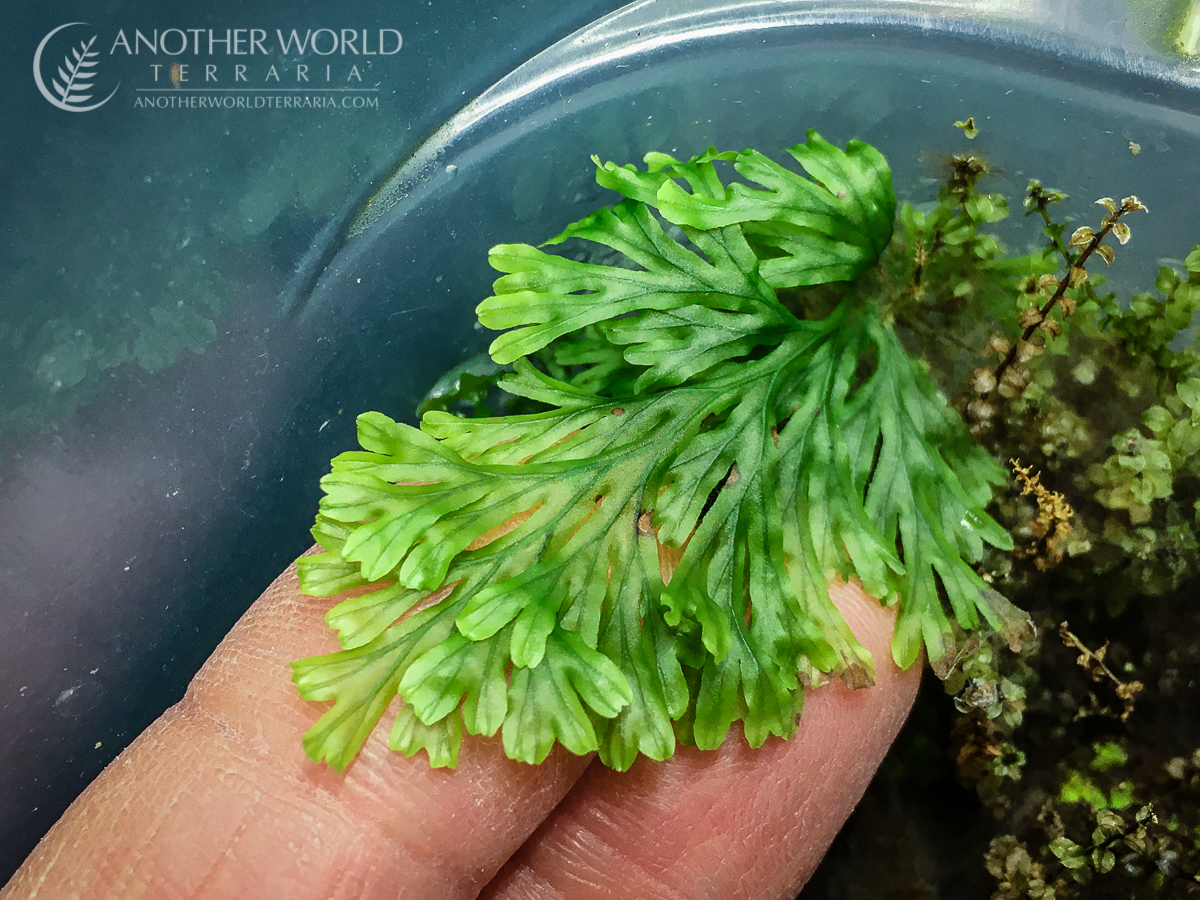
Unidentified filmy fern
As you can see, filmy ferns require specialized conditions to survive and grow well, and present a number of challenges in culture. Great care and patience will be required, but if you are successful, you’ll be rewarded with beautiful and unique plants that are a joy to behold.
References
- Michael C. F. Proctor, “Light and desiccation responses of some Hymenophyllaceae (filmy ferns) from Trinidad, Venezuela and New Zealand: poikilohydry in a light-limited but low evaporation ecological niche,” Annals of Botany, Volume 109, Issue 5, 1 April 2012, Pages 1019–1026, https://doi.org/10.1093/aob/mcs012
- “Hymenophyllaceae,” Wikipedia, https://en.wikipedia.org/wiki/Hymenophyllaceae
Image Credits
- Hymenophyllum nephrophyllum Kidney Fern Ship Creek Beach 2.JPG by MurielBendel licensed under the Creative Commons Attribution-Share Alike 4.0 International license and was modified with general enhancements for color and contrast. Description: Kidney fern (Hymenophyllum nephrophyllum) near Ship Creek Beach, West Coast, South Island, New Zealand.
- Crepidomanes minutum utiwagoke01.jpg by Keisotyo licensed under the Creative Commons Attribution-Share Alike 3.0 Unported, 2.5 Generic, 2.0 Generic and 1.0 Generic license and was modified with general enhancements of cropping, color, and contrast.
- Filmy Fern (3162870189).jpg by Jason Hollinger licensed under the Creative Commons Attribution 2.0 Generic license and was modified with slight adjustments to contrast, color, and exposure. Description: Hymenoglossum cruentum (Cav.) C. Presl. 20090101 Parque Nacional Chiloe, Chile
- Hymenophyllum obtusum (palailaulii) (5868436134).jpg by John Game licensed under the Creative Commons Attribution 2.0 Generic license and modified by adjusting contrast, color, and cropping. Description: Hymenophyllum obtusum (palailaulii). Broader fronds and distinctively branched hairs help distinguish this small but attractive filmy fern from the related Hymenophyllum (Sphaerocionium) lanceolatum. The linear bright green fronds are the fern Adenophorus tenella. Epiphytic on a shady log, Poamoho Trail, Oahu.
- Mindo-Cloud-Forest-05.jpg used from Public Domain courtesy of Ayacop and modified with slight adjustments to contrast and color. Description: Cloud forest near Mindo, Ecuador
- Cloud forest panama 2.jpg contributed by DirkvdM licensed under the Creative Commons Attribution 1.0 Generic license and modified with adjustments to contrast and color. Photograph by Dirk van der Made (en:User:DirkvdM – for more photos see en:user:DirkvdM/Photographs). A cloud forest near Santa Fe, Panamá, April 2004.
- Monteverde Reserve Costa Rica 17.jpg by Cephas licensed under the Creative Commons Attribution-Share Alike 4.0 International license and modified with slight adjustments to color and contrast. Description: Monteverde Cloud Forest Reserve, Monteverde, Costa Rica

